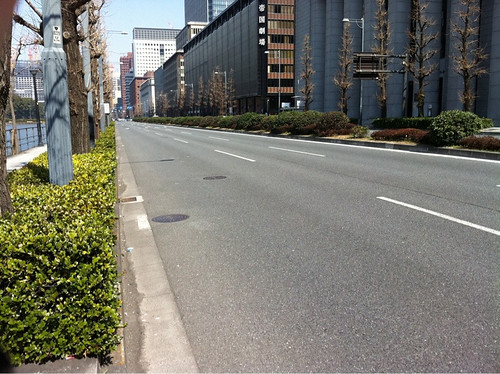On Sunday I go out to the street to walk around the city. 80% of subway lines in Tokyo are already running and we can move with certain liberty. I can see how the Shinkansen service to the south-west of Japan is running smoothly:

Bullet train coming out of Tokyo Station on Sunday morning.
There are very few people on the streets compared to a normal Sunday in Tokyo. I walk around the surroundings of the Emperor Palace; the security area around the palace has been increased, most likely as an extra security measure because of the earthquake on Friday.

The Japanese Emperor Palace two days after the earthquake.
While I’m walking, I feel how the ground is vibrating once again, the trees are shaking a little bit, I stop to see if it’s going to get stronger or not. Luckily, after twenty seconds, it stops and everything is back to normal again. I see on Twitter that it was a small earthquake of 5.8 with epicenter in one of the prefectures to the north of Tokyo.

At the parks around the palace there’s barely any people, normally they are full of tourists.

Downtown streets near Tokyo Station are empty.
I go back home soon to get the latest news about the tragedy. When I sit in front of my computer I feel how another earthquake is coming. To confirm that it is in fact an earthquake, what everybody does is to check the curtains or a lamp to see if they are really moving or not. When you have lived through several days of continuous seismic movements every two or three hours, you end up having “earthquake hallucinations”. You think that everything is moving, but it turns out to be a product of the imagination of your brain. It is something similar to when you go on a boat and you are not used to it, when you step on solid ground again you still feel some kind of dizziness. I look at the curtains carefully and it seems like they are not moving at all; luckily it’s me the one that is making up the earthquake in his brain.
To clear up my mind I take a shower, but this time I’m not lucky enough and an earthquake catches me while I’m showering. It’s not very cool that all the house moves while you are showering, but I take it easy and stupidly laugh at myself.
More posts about the March 2011 Earthquake:

4 replies on “How I lived the greatest earthquake in the history of Japan – Part 5”
How is the water shortage? Is it really bad? I hear that 80% of the water in Japan is contaminated with radiation. Was hoping if you could confirm this news.
Thank you for letting me know that things are getting back to normal. Many are praying for those hurt and suffering in Japan.
What a loaded article. The streets of Marunouchi are always empty on a Sunday. I work in that area and sometimes have to go into the office on Sunday. Besides the Maru-biru and Shin Maru-biru hardly anything is open in the area. I normally have to walk toward Kanda just to find an open conbini. It’s empty earthquake or not.
Tourists don’t often stop in the parks in your photos either. Normally they’ll walk into the park inside the moat, but they don’t loiter around the parks outside of it. There isn’t much to see. There are a lot of Japanese from the nearby offices that hang out there in weekdays for lunch.
Glad to hear the quakes are calming down.
Stay safe, best wishes, great updates btw.
I was in Japan during a (small) quake. it was laughable to the residents, it was my first quake. I’ve only visited 3 times but I always think of it as a second home (my most visited place after the US) and the friends I made there are for a lifetime. So imagine my distress about the whole earthquake and following tragedies. While my friends there say things are okay, I’m always worried for them. thanks for the updates, glad to see things are slowly going back to normal, though they are not out of the woods yet. Good luck out there.